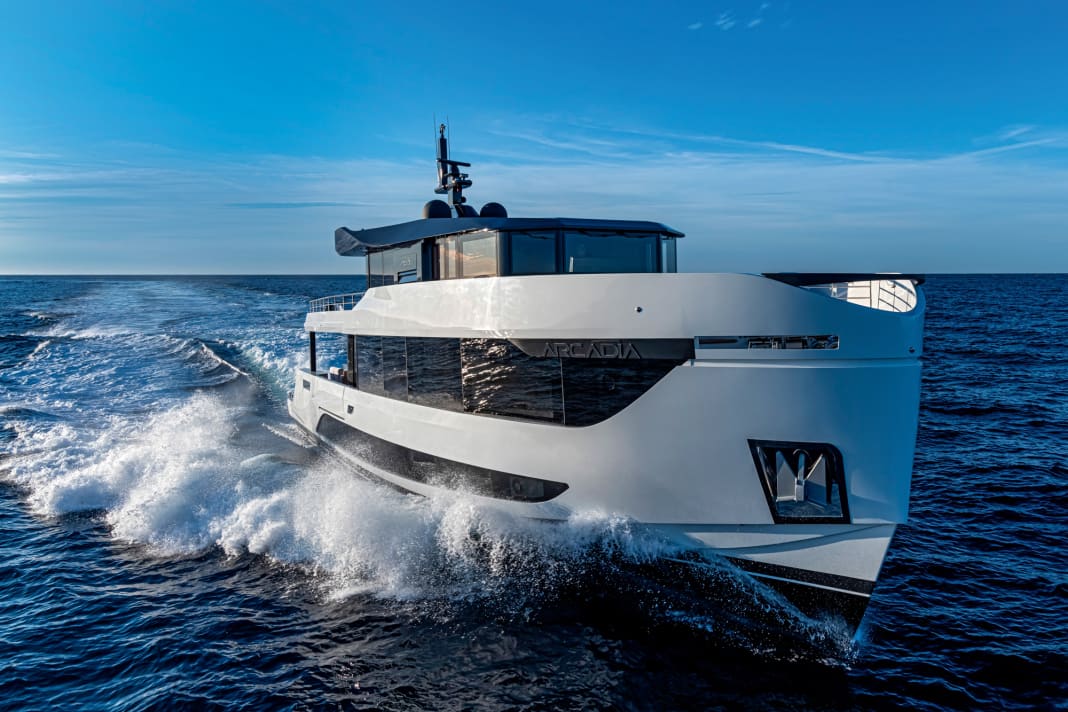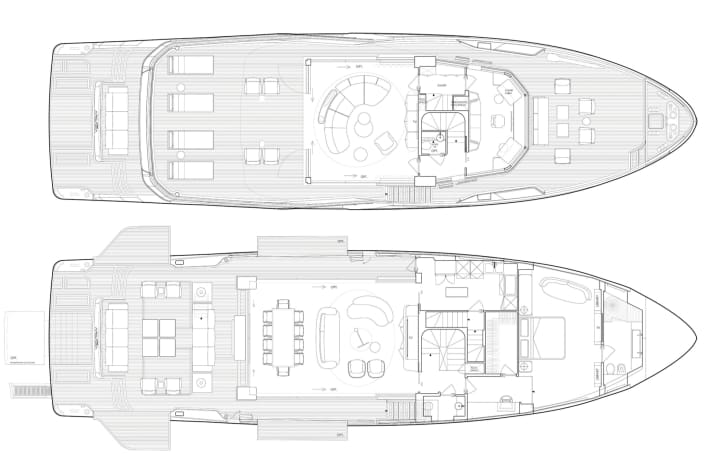





The whole package of exterior and interior design plus layout - for a designer, this is an immense undertaking and a great opportunity to put his personal stamp on a yacht. Igor Lobanov did not hesitate for long to accept the offer from the Italian shipyard. "The concept was simply good," says the qualified automotive designer. The A96 with a GRP hull and superstructure combines the best of two familiar worlds: The stern terraces, excellent driving characteristics plus manoeuvrability and the maximum speed of 23 to 24 knots are similar to Arcadia's Sherpa line, while the immense volume (214 gross tonnes), living comfort and service standard come from the A series. On the A96, a compact 29-metre format - including a mini draught of 1.77 metres - now meets a superyacht ambience that extends over 415 square metres of living space, around 30 percent more than on comparable yachts of a similar size. "All the good ideas currently available on the market are combined here," summarises Lobanov.
This order is the first collaboration with the Russian-born designer and the construction site not far from Mount Vesuvius, and the eight-metre-wide three-decker is also one of his first complete interiors. "We normally approach our projects from the outside, I'm actually an exterior designer," he emphasises. His Barcelona-based studio was given more manpower for the A96, with another designer joining the three interior professionals and six exterior specialists. A second Arcadia has long been on Lobanov Design's order books, and it is more than likely that more will follow. According to the shipyard, the second unit sold within minutes of the first during the A96 debut at the Cannes Yachting Festival.
Proportions between the rooms are important
Once the contracts between the shipyard and designer were signed and sealed for construction number one, things had to move quickly - after all, the world premiere last September couldn't wait. "It was a well-coordinated machine," says Lobanov, who likes to emphasise that he speaks Italian, which simplified communication. When a design team has an overview of almost everything at the same time, this benefits the processes and ultimately the ambience on board. "The proportions between the rooms are important; if they are good, you also feel good," explains Lobanov. "We tackle the architecture first, then the decoration."
So the designer began with the exterior design, playing with contrasts and also bringing out familiar Arcadia features. He drew a relatively small, angular, dark grey wheelhouse plus skylounge and placed it on a voluminous base in white. Thanks to the high bulwarks at the bow, the hull appears to be raised high, with the main deck looking like a second lower deck. At first glance, the ensemble appears somewhat massive and bulky, but on closer inspection it reveals itself to be a harmonious overall picture: soft, harmonious and open. Finally, Studio Lobanov also utilised the dimensions of the window areas to the full.
Standing in the 24 square metre saloon, with sliding doors open to the 47 square metre rear terrace, with folding balconies folded down on both sides, the impression is of much more space and size. "The walls no longer exist here," says the designer. The high ceilings also help you breathe freely. "The height is also good for ventilation," adds Lobanov. Open spaces that flow seamlessly into one another, with nature, the sun and the sea within reach, and materials that are as sustainable as possible - all of this was on the owners' long wish list. While they value socialising, enjoy sitting together with guests or watching the captain at work from the sofa in the wheelhouse, they also wanted peace and quiet from time to time. They enjoy their private retreat in the master suite on the forward main deck or on the bow terrace, which offers plenty of privacy thanks to the high bulwarks, but only when the wheelhouse is not occupied. In any case, the area is only romantic if desired, as the filigree furnishings quickly and easily make room for stowing watercraft. A small crane is waiting to be used on the port side. Anyone looking for a "real" hiding place will find it in the bow. A few steps lead down to the small forepeak, where anchors and winches are placed on deck in a beautifully nostalgic way for everyone to see.
The interior of the Arcadia A96 is "a mix of Scandinavian and Art Deco"
For the interior, the designer drew from various drawers: He used soft shapes, warm fabrics, leather and fine silk carpets against high-gloss lacquer, strikingly grained marble, textured wood and stone with a rough, untreated surface and 3D effect. Against the classic colour backdrop of beige plus anthracite, the studio sprinkled shimmering gold lamps, table frames and cushions. Lobanov loves strong contrasts and describes the interior of the A96 as "eclectic", but doesn't really want to categorise it: "It's a mix of Scandinavian and Art Deco." The furniture is largely made in Italy: the monochrome upholstered seating was supplied by classic brands such as Minotti, Pedrali, Baxter and Paolo Castelli. On the outdoor terraces, guests sit on chairs by Roda and relax on loungers by Meridiani. The long table with marble top for the dining area in the salon is by Marelli, the coffee table in the skylounge by Valentini.
The style extends from the lower deck up to the upper deck, whose saloon opens up to the side decks via sliding doors and glass solar panels in the ceilings let in additional daylight. If invited by the owner, Lobanov would prefer to sit on the long Baxter sofa, watch the sun rise or set and "maybe have a drink" in the evening.
The crew discreetly bring the gin and tonic from the adjoining galley, which is directly connected to the galley below via a few steps and finally to the cabins on the lower deck. As is customary on the really big ships, guests take separate routes, using their own staircase to get from the upper deck to the Beletage with the main saloon and then down to their suites.
The designers also made sure that nobody on board has to walk unnecessary distances, for example there is also the option of integrating a small toilet into the stairwell on the upper deck. Efficiency is a kind of motto that runs through the yacht's floors. Arcadia's engineers put a lot of work into saving weight, for example by laying cables and pipes so meticulously that the A96 displaces just 130 tonnes when fully loaded. One tonne per 1.7 gross tonnes naturally also saves fuel and helps to achieve a remarkable range of 1500 nautical miles at a speed of ten knots. A maximum speed of just under 24 knots is targeted, while in cruising mode the yacht should be travelling at 19 to 20 knots.
Excellent manoeuvrability thanks to fourVolvo Penta IPS packages
The source of this performance range is remarkable: the engine compartment, which is well sealed against noise and vibrations, contains four Volvo Penta IPS packages which, together with the bridge technology from Garmin, guarantee one thing above all: outstanding manoeuvrability. Within just a few weeks, the Arcadia was able to prove just that in the crowded exhibition harbours of the Mediterranean. Shortly after delivery and her debut in Cannes, the yacht and crew embarked on their next voyage and also moored in Monaco.
Volvo supplies the assisted docking system for uncomplicated docking. "It has greatly simplified my manoeuvres," confirms shipyard captain Mario De Camillis. "I can manoeuvre the yacht easily, even in tight spaces." Even in strong winds or currents, the technology increases safety, as the drift effects are eliminated and the ship automatically stays on course. "It also reduces the stress on the engines and steering systems," continues De Camillis, "as the forwards and backwards movements and accelerations are reduced." The experienced captain and law graduate adds another point here: "The system also reduces the psychological stress of guests and crew when we dock in challenging weather conditions."
Everything can be kept in view on board the Arcadia
The 360-degree vision system, which was also developed with Garmin and works with six cameras integrated into the hull, comes to the rescue. "This allows us to monitor the entire perimeter at a glance - both underway and when manoeuvring," says De Camillis. "I can immediately see the blind spots without having to communicate with the crew." The screen on the bridge shows the distance to other yachts or obstacles, and a "visual fender" appears when mooring, which changes colour if the pier gets too close. Virtual manoeuvring instructions provide additional support. When mooring, the captain positions the yacht safely and at an ideal distance from the harbour infrastructure thanks to the cameras. He also has the stern in view: "I can see what the crew is doing there."
For the A96, Arcadia has also focussed on sustainability in addition to all the comfort and safety aspects. But only on request. If customers opt for the "Silent Mode" package, the southern Italian company installs batteries and solar panels with an output of around 4.5 kilowatts. This allows up to nine hours of emission-free hotel operation. The air conditioning systems themselves run almost silently. Nothing stands in the way of comfortable cruising in warm climes, and the first two buyers of the new high-volume model have set their sights on the Mediterranean for the time being.
Technical data


- Length over everything: 29,07 m
- Length (hull shape): 23,95 m
- Width: 7,92 m
- Depth: 1,77 m
- Displacement (full):130 t
- Gross tonnage:214 GT
- Material: GRP
- Motors: 4 x Volvo Penta IPS
- Engine power:4 x 735 kW
- Speed (max.): 23.5 kn
- Speed (travelling): 19.5 kn
- Generators:2 x 35 kW
- Fuel: 12 700 l
- Water: 2000 l
- Guests/crew: 10/5
- Construction: Arcadia Yachts
- Exterior design: Arcadia, Lobanov Design
- Interior design:Lobanov Design
- Class: R.I.N.A.
- Shipyard: Arcadia Yachts, 2023
- Starting price: 9.3 million euros

